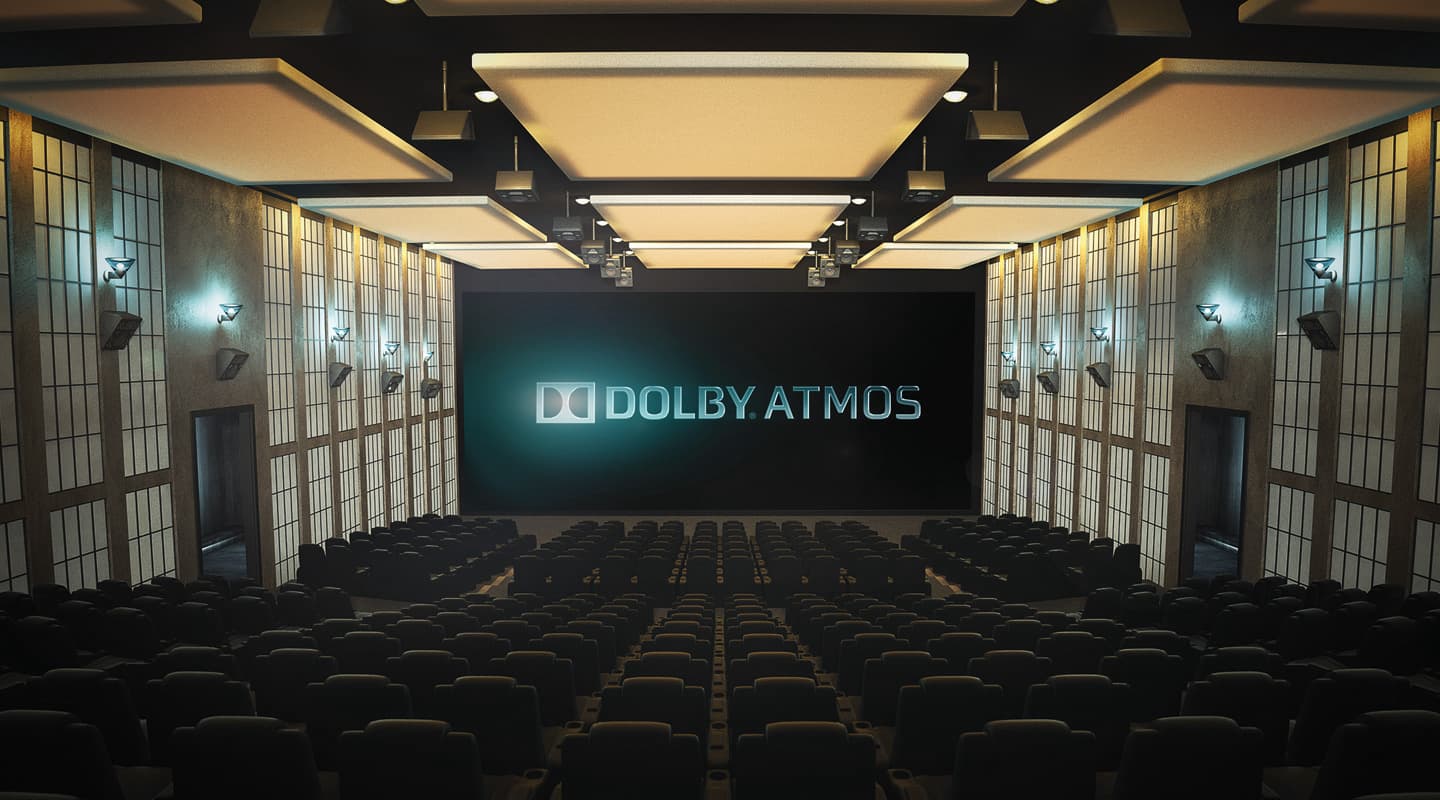
Immersive Sound in the Cinema
Setting the new cinema standard.
Text:/ Robert Clarke
The next generation of cinema sound promises to deliver a truly three-dimensional audio experience. New immersive audio systems are already being deployed in theatres around the globe, but before this technology can become truly universal, an open immersive sound standard needs to be published. Currently, the Society of Motion Picture and Television Engineers (SMPTE) is mediating between some highly-competitive brands to agree upon what that standard will be. Here’s a breakdown of the three frontrunners in immersive audio and what they’re bringing to SMPTE’s negotiating table.
CHANNELLING THE EFFECTS
There are currently two different approaches to immersive sound in the cinema. The more familiar channel-based approach is to have speakers placed in specific zones in the theatre’s acoustic space. Sounds are panned between zones during mixdown to precisely place each source in the auditorium. The sound for each zone is generally recorded, distributed and replayed on its own independent channel of a multi-channel recording. There are several multi-channel surround sound formats (5.1, 7.1, 9.1, etc,) each with its specific number of signal channels and specified speaker placement. Material created for one multi-channel format is generally locked into that format by the sheer effort required to remix it for another speaker configuration, especially if the target format has more channels.
(above) A model of a Dolby Atmos auditorium where speakers completely encompass the audience.
“”
sounds are treated as discrete objects located in the three-dimensional acoustic space of the auditorium
(right) A model of the Auro 11.1 system licensed to Barco showing the three layers of this system: the existing 5.1 surround (orange), the additional height layer (blue) and the additional overhead layer (magenta).
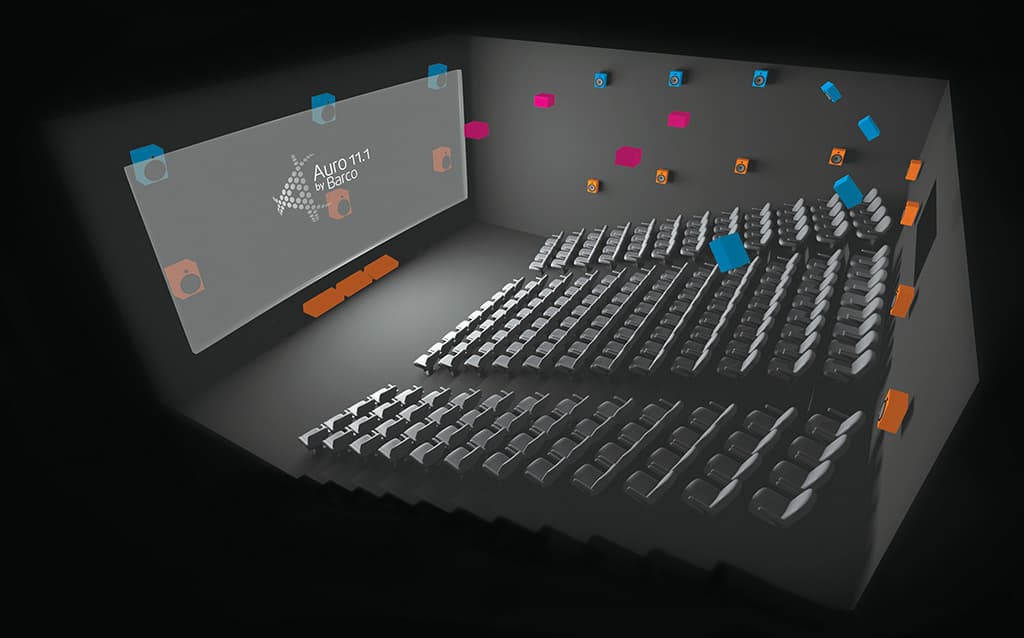
OBJECTIVELY SPEAKING
The other, more recently developed approach is being identified as object-based audio. In this approach, sounds (eg. voices, effects, instruments, etc) are treated as discrete objects located in the three-dimensional acoustic space of the auditorium. During mixdown each sound object is recorded along with information about its location. On replay, digital signal processing is used to calculate the most accurate possible placement of the sound using the actual multi-channel replay system in the screening space. While entailing much more signal processing at time of replay, object-based replay is intended to provide the optimum placement of each sound that’s possible in any given configuration and so can take advantage of as many speaker channels as an exhibitor chooses to provide.
AURO 11.1 BY BARCO
Projector manufacturer Barco’s new Auro 11.1 system – licensed from Auro Technologies’ Auro 3D system – assigns audio elements to specific channels, but doubles the 5.1 surround system into low and high rows on the left, right and rear walls, and adds left and right overhead speaker ‘stripes’ on the ceiling.
Barco’s senior director of business development, Brian Claypool, says Auro 11.1 fulfilled a need expressed by the industry for an updated immersive audio technology that could “keep as much standard workflow practices as possible.” Further to this aim, Auro is mastered in 11.1 but then encoded into a 5.1, linear PCM stream. A Barco installation is also adaptable to any object-based standard that may arrive. Its processors all have slots for expansion modules to support object-based rendering, and Auro Technologies’ content-creation tools can already mix in, and export, object-based audio (including MDA – see below). Claypool adds, “Even though going object based makes things slightly more complex on the production and distribution side, we’ve designed the system to ensure that when we upgrade to support those modes, it’s not cost-prohibitive for exhibitors to support it.” So far, more than 50 titles have been mixed in Auro 11.1, including Superman 2 for example, and it has been adopted in over 35 major studios. For 2014, it is either deployed or committed in over 450 screens worldwide.
DTS MULTI-DIMENSIONAL AUDIO
MDA (Multi-Dimensional Audio) is an object-based immersive audio model that was invented by SRS Labs and acquired by DTS. As VP of Emerging Technologies at DTS, Ton Kalker says, “MDA is object based, it’s immersive, and we want to offer it as an open standard and royalty free”.
Barco is part of an alliance of content creators, tool makers, exhibitors and studios that are backing and actively contributing to MDA as a viable new standard. The alliance, known as the MDA Proponents Group, aims to deliver a platform ranging “from production to rendering in an actual cinema,” says Kalker. This includes specifying the relevant metadata for an object-based audio stream, defining how that metadata translates into an ‘acoustical experience, and turning this audio model into an actual bitstream. While more speakers will ensure better immersion, being object-based, MDA playback will not necessarily be contingent on a specific speaker configuration. Kalker explains: “You could play it back in a theatre with 48 speakers, or you could play it at home with 5.1, stereo, or what have you. It’s the same bit-stream but it’s rendered differently depending on the context.”
DOLBY ATMOS
While MDA has been tested in theatres with what Kalker refers to as ‘professional content’, it has not yet been commercially deployed. This is in stark contrast to the deployment of Auro 11.1 and Dolby’s Atmos system, and could work against MDA at the negotiating table. As Dean Bullock of Dolby laboratories argued at this year’s CinemaCon convention in Las Vegas: “We don’t want to standardise on theory; we don’t want to standardise on unknown technologies.” Rather, he asserts that the best standards are those based on what works in the real world. That real world has Dolby’s Atmos installed or guaranteed in over 450 screens worldwide for 2014, has been used to mix over 100 titles (The Hobbit: An Unexpected Journey is a notable recent example) and is already employed in over 55 mixing facilities.
Like its competitors, Dolby Atmos requires overhead speakers, but in contrast to Auro 11.1 it retains a single surround layer that is filled in with additional speakers behind the screen and in the side surrounds. This is to enhance its pan-through array technology, which frees individual speakers from zones and allows them to operate independently or as groups (which it calls ‘beds’) to position sounds in a three-dimensional space. It is essentially a hybrid system, utilising a combination of object- and channel-based technology. As Bullock notes, Dolby Atmos is also designed to be adaptable, meaning it can export in a format that, “Correctly and accurately renders the artistic intent of the mix in any-sized room that has been configured for Dolby Atmos playback.”
SMPTE’S ROLE
Importantly, it isn’t actually up to SMPTE to decide what the new standard will be. As John P. Maizels, the society’s Regional Governor for Asia/Australia, points out: “SMPTE’s responsibility is to identify areas in which standards need to be developed and then bring together and manage the people who ultimately develop them. It then publishes and maintains the resulting standards.” So, contrary to what many may assume, SMPTE cannot mandate or police the implementation of standards. Maizels further adds that the society serves three distinct roles: membership, education and standards, the first two of which are the sole focus of its Australian section.
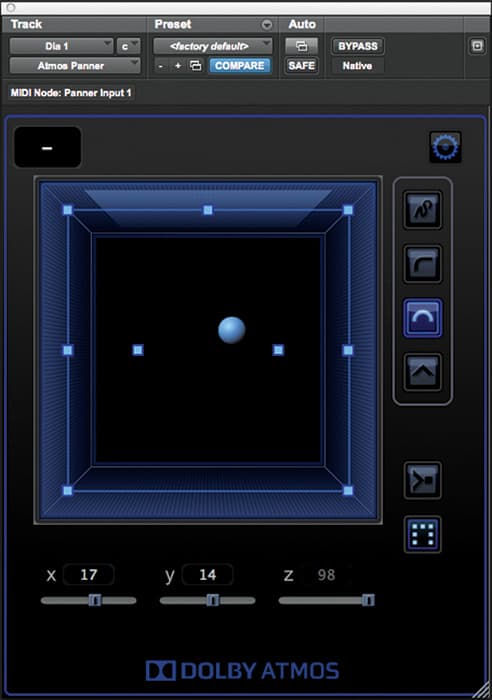
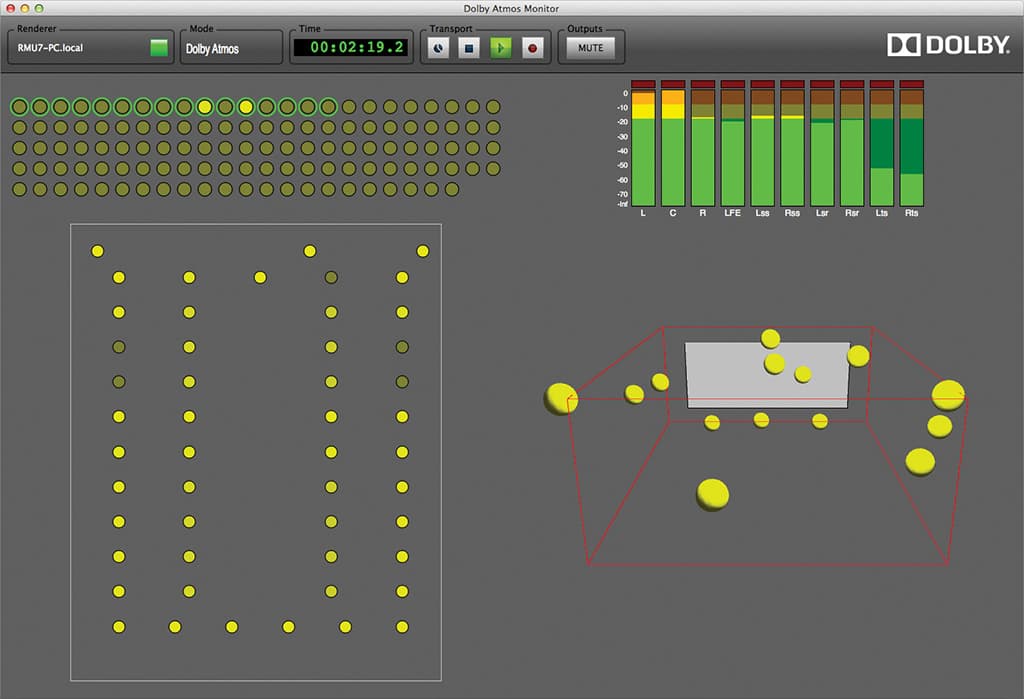
ENTER SMPTE
Clearly all of the above mentioned systems are effective and catching on, but for a truly open, interoperable standard to emerge, no one brand can (or should) simply become the next standard. That’s why SMPTE was asked by studios, exhibitors, industry bodies and manufacturers alike to mediate. It established a working group entitled 25CSS (CSS stands for Cinema Surround Sound), and the chair of this committee is the CTO of San Francisco’s Mission Rock Digital, Pete Ludé. He says the competing manufacturers aren’t necessarily vying for their own tech to become the new standard. “Everybody is very anxious to work towards an open system,” says Ludé, “and if there is proprietary technology, that would be made available under appropriate licence terms, but for the most part, I think all of the proponents feel that they compete in the marketplace based on the theatre equipment and the actual implementation.”
THE ROAD AHEAD
At the end of the day, it may be the studios and exhibitors who have the most at stake in getting this standard published in a timely fashion, as they are the ones spending time and money mixing and implementing numerous audio formats for every film. As Barco’s Brian Claypool admits, once Auro and Atmos started to gain traction with exhibitors, “the studios kind of pushed back on both of us and said, ‘now hold on you guys, you have got to talk to each other.’”
Regardless of what form the new standard takes, the implications for audiences are significant. After all, the next generation of immersive audio has been compared to the leap between stereo and 5.1. Ludé anticipates that a standard will be agreed upon within 12 months, and we can be certain that Barco and Dolby will continue to push the adoption of their proprietary systems in the meantime. So watch, or should I say listen to, this (3D) space.
MORE INFORMATION:
Barco Auro 11.1: www.barco.com/en/auro11-1
Auro Technologies: www.auro-3d.com
DTS: www.dts.com
Dolby Atmos: www.dolby.com/atmos
SMPTE: www.smpte.org


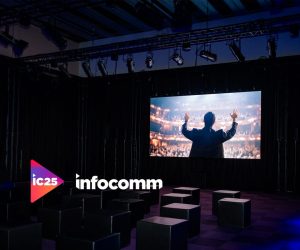
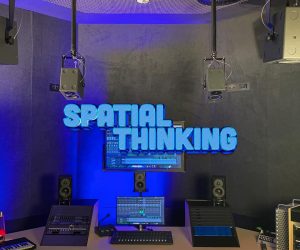
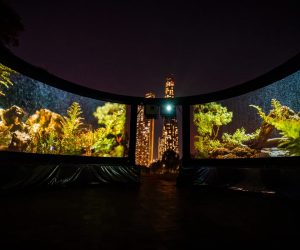



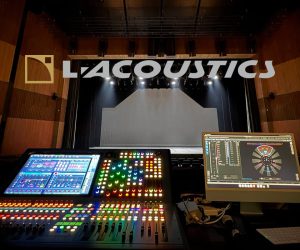






RESPONSES